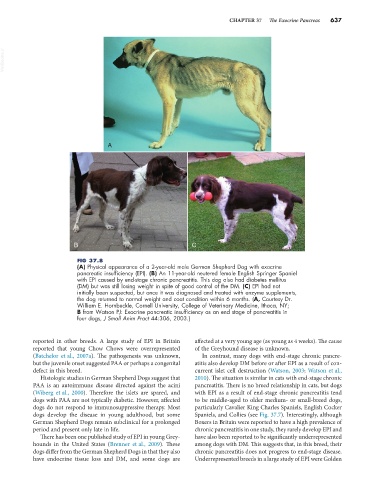Page 665 - Small Animal Internal Medicine, 6th Edition
P. 665
CHAPTER 37 The Exocrine Pancreas 637
VetBooks.ir
A
B C
FIG 37.8
(A) Physical appearance of a 2-year-old male German Shepherd Dog with exocrine
pancreatic insufficiency (EPI). (B) An 11-year-old neutered female English Springer Spaniel
with EPI caused by end-stage chronic pancreatitis. This dog also had diabetes mellitus
(DM) but was still losing weight in spite of good control of the DM. (C) EPI had not
initially been suspected, but once it was diagnosed and treated with enzyme supplements,
the dog returned to normal weight and coat condition within 6 months. (A, Courtesy Dr.
William E. Hornbuckle, Cornell University, College of Veterinary Medicine, Ithaca, NY;
B from Watson PJ: Exocrine pancreatic insufficiency as an end stage of pancreatitis in
four dogs, J Small Anim Pract 44:306, 2003.)
reported in other breeds. A large study of EPI in Britain affected at a very young age (as young as 4 weeks). The cause
reported that young Chow Chows were overrepresented of the Greyhound disease is unknown.
(Batchelor et al., 2007a). The pathogenesis was unknown, In contrast, many dogs with end-stage chronic pancre-
but the juvenile onset suggested PAA or perhaps a congenital atitis also develop DM before or after EPI as a result of con-
defect in this breed. current islet cell destruction (Watson, 2003; Watson et al.,
Histologic studies in German Shepherd Dogs suggest that 2010). The situation is similar in cats with end-stage chronic
PAA is an autoimmune disease directed against the acini pancreatitis. There is no breed relationship in cats, but dogs
(Wiberg et al., 2000). Therefore the islets are spared, and with EPI as a result of end-stage chronic pancreatitis tend
dogs with PAA are not typically diabetic. However, affected to be middle-aged to older medium- or small-breed dogs,
dogs do not respond to immunosuppressive therapy. Most particularly Cavalier King Charles Spaniels, English Cocker
dogs develop the disease in young adulthood, but some Spaniels, and Collies (see Fig. 37.7). Interestingly, although
German Shepherd Dogs remain subclinical for a prolonged Boxers in Britain were reported to have a high prevalence of
period and present only late in life. chronic pancreatitis in one study, they rarely develop EPI and
There has been one published study of EPI in young Grey- have also been reported to be significantly underrepresented
hounds in the United States (Brenner et al., 2009). These among dogs with DM. This suggests that, in this breed, their
dogs differ from the German Shepherd Dogs in that they also chronic pancreatitis does not progress to end-stage disease.
have endocrine tissue loss and DM, and some dogs are Underrepresented breeds in a large study of EPI were Golden

